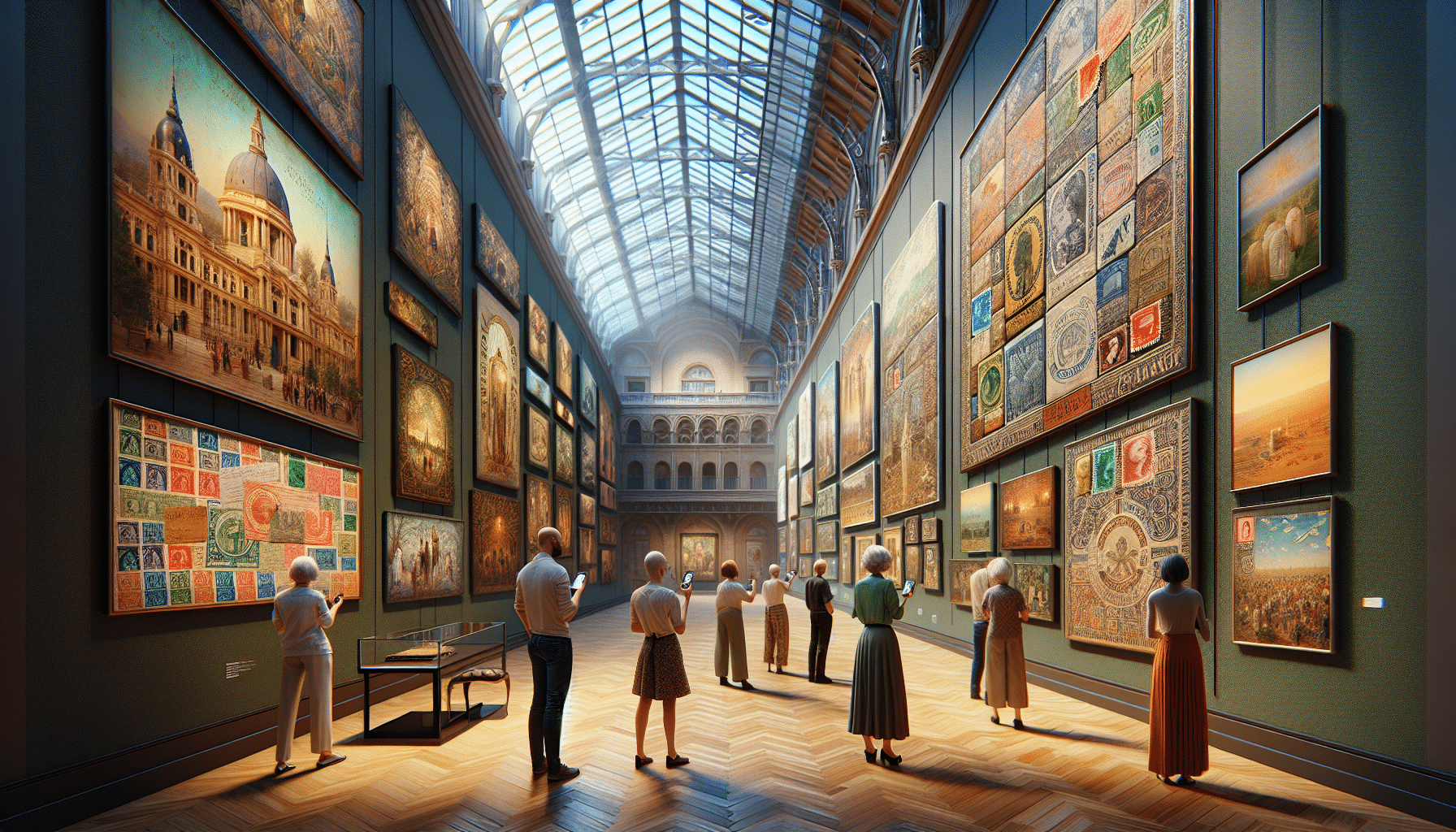Anúncios
In the quiet hum of an artist’s studio, the tactile experience of creating art by hand is unparalleled. The texture of paper, the glide of ink, and the satisfaction of a perfectly placed stamp are all sensations that ignite the creative spirit. However, as we navigate an increasingly digital world, a new frontier for artistic expression emerges—one that combines the tangible with the virtual, tradition with innovation. Enter the captivating realm of digital reproductions of classic mail art archives, where the boundaries of creativity and communication are redefined, offering art enthusiasts and creators alike an opportunity to connect with the past while forging new pathways to the future. 📬✨
Anúncios
Mail art, a movement that flourished during the latter half of the 20th century, transformed ordinary postal materials into extraordinary works of art. It was an avant-garde rebellion against the conventional art establishment, emphasizing accessibility, collaboration, and the sheer joy of creation. Artists from around the globe sent postcards, decorated envelopes, and crafted objects through the mail, forming a vast network of creative exchange. Fast forward to today, and we find ourselves at the intersection of this rich history and the digital age, where technology offers us the ability to preserve, explore, and share these artistic treasures in ways previously unimaginable. Digital reproductions not only safeguard these fragile pieces from the ravages of time but also democratize access, allowing anyone with an internet connection to become a participant in this vibrant artistic dialogue.
Anúncios
The Evolution of Mail Art: A Journey Through Time
Mail art, a unique and captivating form of artistic expression, has undergone a fascinating evolution since its inception. Rooted in the avant-garde movements of the early 20th century, mail art emerged as a form of artistic communication that defied traditional boundaries. In its early days, artists like Marcel Duchamp and Ray Johnson began to use the postal service as a canvas, creating a global network of art exchange that transcended geographic limitations.
The significance of mail art lies in its ability to democratize art. By utilizing the postal system, artists were able to bypass galleries and museums, bringing art directly into people’s homes. This not only challenged the elitism often associated with the art world but also fostered a sense of community among artists and recipients. The collaborative and inclusive nature of mail art is what continues to make it relevant today.
In the digital age, the concept of mail art has expanded further. With the advent of the internet and digital tools, artists are now able to create, share, and archive their works in ways that were previously unimaginable. Digital reproductions of classic mail art archives allow us to explore these artistic treasures in new and exciting ways, providing both an educational resource and an inspiration for contemporary creators.
Understanding the Impact of Digital Reproductions
Digital reproductions of mail art archives serve as a bridge between the past and the present. By digitizing these collections, institutions and individuals have made it possible for a wider audience to access and appreciate the intricate details and historical significance of mail art. This not only preserves the original works but also ensures that the legacy of mail art is carried forward.
One of the key benefits of digital reproductions is accessibility. Unlike physical archives, which may be located in specific museums or personal collections, digital archives can be accessed from anywhere in the world. This democratization of access aligns with the core principles of mail art, allowing anyone with an internet connection to explore and appreciate these works.
Furthermore, digital reproductions offer enhanced interactivity. Through high-resolution images and interactive platforms, viewers can engage with the art in a more intimate and detailed manner. Some platforms even allow users to zoom in on specific sections, revealing textures and techniques that might be overlooked in physical form.
Comparing Physical and Digital Archives
When it comes to preserving and showcasing mail art, both physical and digital archives have their merits. While digital reproductions provide unparalleled access and convenience, physical archives offer a tangible connection to the artwork’s history and materiality. Below is a comparative table highlighting the strengths of each:
| Aspect | Physical Archives | Digital Archives |
|---|---|---|
| Accessibility | Limited to location and opening hours | Available online 24/7 |
| Interactivity | Physical engagement with original materials | High-resolution images and zoom capabilities |
| Preservation | Vulnerable to damage and deterioration | Preserved in digital format indefinitely |
| Cost | Maintenance and space costs | Initial digitization costs |
Exploring Notable Mail Art Archives
To truly appreciate the breadth and depth of mail art, it’s essential to delve into some of the most notable archives and collections. These repositories not only showcase the creativity of individual artists but also reflect the collaborative spirit of the mail art movement.
The Ray Johnson Estate is one such collection that offers a comprehensive look at the works of one of the founding figures of mail art. Johnson’s playful and enigmatic style is evident in his correspondence, which often included drawings, collages, and pithy phrases. His work has been digitized and made available for public viewing, allowing new generations to explore his innovative contributions.
Another important archive is the Jean Brown Papers, housed at the Getty Research Institute. This collection contains a wealth of material related to the Fluxus movement, which played a significant role in the development of mail art. By examining these archives, researchers and enthusiasts can gain insight into the dynamic interplay between art and communication during this pivotal period.
Discover More Through Videos
To deepen your understanding of mail art and its digital preservation, consider exploring video resources that offer visual and contextual insights. One such video is “Mail Art: A Global Movement” by The Art Assignment on YouTube. This engaging video provides an overview of the mail art movement and its continued relevance in the digital age.
Watch here: Mail Art: A Global Movement – The Art Assignment
Creating and Sharing Your Own Mail Art
Inspired by the rich history and innovative spirit of mail art, many contemporary artists are exploring ways to create and share their own works. The digital landscape offers a plethora of tools and platforms that make it easier than ever to engage with this unique art form.
One approach is to participate in online mail art exchanges, where artists can send and receive works from around the world. Websites and forums dedicated to mail art provide spaces for artists to connect, collaborate, and showcase their creations. Additionally, social media platforms like Instagram and Pinterest offer opportunities for artists to reach a wider audience and receive feedback on their work.
For those interested in preserving their own mail art creations, digitization is a valuable tool. By scanning or photographing works, artists can create digital portfolios that showcase their art while ensuring its longevity. This also allows for easy sharing and collaboration with fellow artists and enthusiasts.
- Participate in online mail art exchanges
- Connect with artists on dedicated mail art forums
- Showcase your work on social media platforms
- Create a digital portfolio of your mail art
In conclusion, the exploration of digital reproductions of classic mail art archives offers a fascinating journey into a unique and vibrant form of artistic expression that has shaped the cultural landscape in myriad ways. Throughout this article, we have delved into the history, significance, and impact of mail art, uncovering how it emerged as a democratic and inclusive art form that transcends traditional boundaries. By embracing the possibilities offered by digital technology, these once ephemeral artworks are now preserved and made accessible to a global audience, allowing a new generation to appreciate and engage with this rich heritage.
One of the primary points discussed is the democratizing nature of mail art. Originating in the 1960s and 1970s, mail art became a medium through which artists could communicate and collaborate without the constraints imposed by galleries and museums. The mail art network thrived on principles of openness, inclusivity, and the sharing of ideas, fostering a sense of community among artists worldwide. In the digital age, these values are amplified, as online platforms enable even broader participation and interaction, preserving the spirit of mail art in a contemporary context.
The importance of archiving and digitizing mail art cannot be overstated. As physical pieces are vulnerable to the ravages of time, digital reproductions play a crucial role in safeguarding these cultural artifacts for future generations. Digital archives offer researchers, artists, and enthusiasts the opportunity to explore and study mail art collections in unprecedented detail. The preservation of these works not only honors the legacy of past artists but also serves as an inspiration for contemporary creators seeking to innovate within the medium.
Moreover, digital reproductions of mail art provide an invaluable resource for educators and students. By incorporating these materials into educational settings, we can encourage a deeper understanding of artistic movements and the historical contexts in which they arose. Students gain insights into the power of creativity as a tool for communication and activism, learning from artists who used their work to challenge societal norms and address pressing issues of their time.
In addition to preserving history, digital platforms foster collaboration and innovation. Artists today can draw inspiration from classic mail art while exploring new techniques and technologies to push the boundaries of what is possible. This fusion of past and present encourages a dynamic exchange of ideas, ensuring that the spirit of mail art remains vibrant and relevant in our ever-evolving cultural landscape.
As we reflect on the journey through digital reproductions of classic mail art archives, it becomes clear that this endeavor is not just about preservation but also about revitalization. By making these treasures accessible, we invite everyone to partake in a shared cultural heritage, transcending geographical and temporal limitations. Whether you are an artist seeking inspiration, a scholar conducting research, or simply a curious observer, there is something to be gained from engaging with these archives.
We encourage you to explore these digital collections further, immerse yourself in the diverse array of artworks, and let them spark your imagination. Consider how the principles of mail art—collaboration, openness, and innovation—can be applied in your own creative pursuits. By sharing your discoveries and insights with others, you contribute to a vibrant community that values creativity and dialogue.
In this digital age, where information flows freely and connections are easily made, the potential for artistic collaboration is boundless. Let us celebrate the legacy of mail art and its contemporary revival by embracing the opportunities for creativity and exchange that digital platforms provide. As you delve into these artistic treasures, remember that your engagement helps keep the spirit of mail art alive, inspiring future generations to explore, create, and connect.
Feel free to comment, share, and discuss your thoughts and experiences with mail art. Together, we can continue to uncover new facets of this captivating art form, ensuring that its impact resonates for years to come. 🌟
For further reading and exploration, you may visit the following resources:
–
– MoMA Archives
Let these archives be your gateway to a world where art knows no bounds, and creativity knows no limits. Happy exploring!

